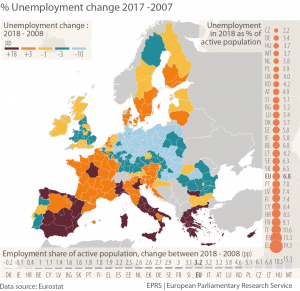The crisis caused unemployment to increase between 2008 and 2018 in the regions marked in brown and orange – mainly in Spain, Italy, Greece, Cyprus, Slovenia, France, Denmark, Lithuania and in parts of Austria, Croatia, the Netherlands, Finland and Sweden. Conversely, it decreased in the regions marked in teal and light blue (in Germany, Hungary, Slovakia, Cyprus, Poland and parts of the UK, Romania and the Czech Republic). At the same time, the employment share of the active population decreased in Denmark and Ireland only, while increasing by more than 5 pp in Poland, the Czech Republic, Lithuania, Hungary and Malta.
At EU level, unemployment rose most between 2008 and 2013, when it reached the record level of 26.5 million (11 %). Afterwards, it began to fall, reaching 6.5 % in March 2019, the lowest level this century. However, the situation varies significantly between Member States, with the highest levels (between 10 and 20 %) persisting in those countries hardest hit by the crises, such as Greece, Italy, Portugal and Spain, while the lowest figure was recorded in the Czech Republic (2.2 %). It is also worth noting that despite undoubted improvements in employment and labour market conditions in Europe, one of the lasting legacies of the crises is high unemployment among young people, particularly in the southern Member States.








Be the first to write a comment.